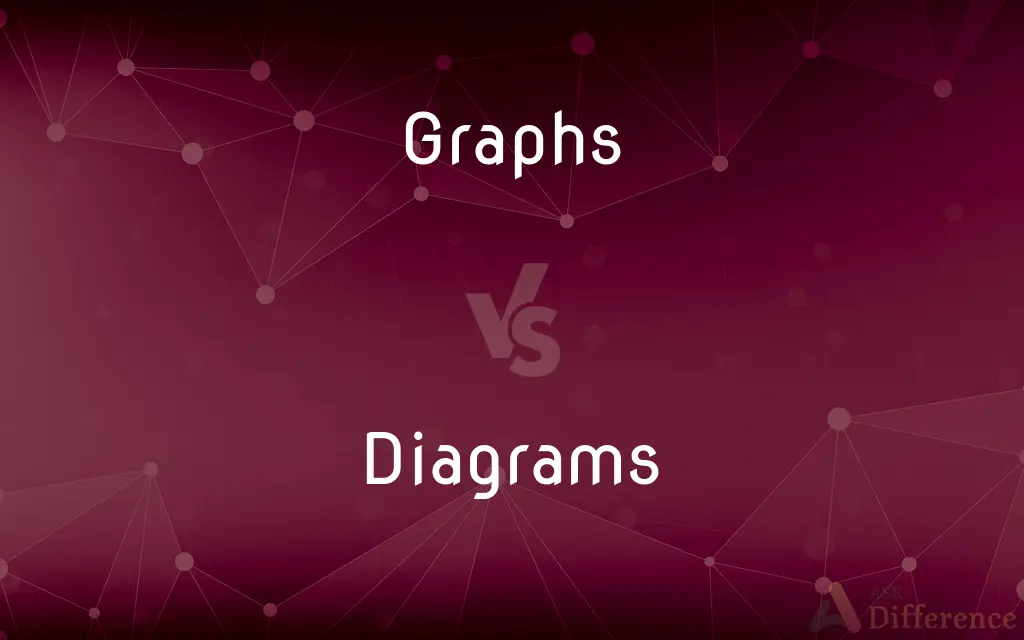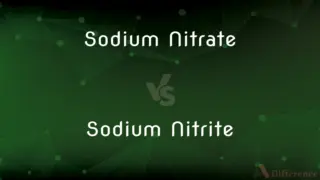Graphs vs. Diagrams — What's the Difference?
By Tayyaba Rehman — Published on November 19, 2023
Graphs represent numerical data visually; diagrams visually represent relationships or processes. Both convey information effectively through varied formats.

Difference Between Graphs and Diagrams
Table of Contents
ADVERTISEMENT
Key Differences
Graphs stand out as potent tools when the objective is to represent numerical data in a visually intelligible manner. Diagrams, on the other hand, serve as visual representatives designed to illustrate a concept, process, or relationship, potentially without the use of numerical data. Graphs generally employ axes, points, lines, or bars to showcase data points and trends, making them instrumental in visualizing and interpreting statistical information.
In contrast, Diagrams can encompass a broad array of visual representations, such as flowcharts, schematics, and organizational charts, to convey intricate concepts, processes, or hierarchical structures succinctly. The potency of graphs is vividly seen in their capability to manifest trends, fluctuations, and correlations in the data, which can be deciphered with relative ease, facilitating quick insights and comparisons.
While graphs underscore the empirical and quantitative, diagrams often hinge on illustrating structural, procedural, or categorical information in a straightforward visual format. Diagrams are versatile, providing clear illustrations of everything from sequential steps in a process (flow diagrams) to structural hierarchies (organizational diagrams), enabling viewers to comprehend and navigate complex information efficiently.
Graphs can vary, encompassing forms like bar graphs, line graphs, and pie charts, each tailored to articulate specific types of data in the most coherent manner. Diagrams are equally varied, offering options like Venn diagrams, which elucidate the relationships between different sets, or circuit diagrams, which convey the workflow within an electrical system.
In educational and professional settings, graphs and diagrams are imperative, simplifying the communication of complex data and concepts. Be it through illustrating data correlations in a line graph or mapping out a process via a flow diagram, both serve to enhance comprehension and retention of information by transforming it into an accessible visual format.
ADVERTISEMENT
Comparison Chart
Data Representation
Numerical
Conceptual/Processual
Purpose
Show Data Trends
Explain Processes/Relationships
Elements
Axes, Bars, Points
Shapes, Arrows, Labels
Example Type
Bar Graph
Flowchart
Usage
Statistical Analysis
Concept Illustration
Compare with Definitions
Graphs
They often include axes that indicate variables or categories.
The graph displays time on the x-axis and revenue on the y-axis.
Diagrams
Diagrams are visual tools that illustrate concepts, relationships, or processes.
The diagram demonstrates how the water cycle operates.
Graphs
Graphs visually represent statistical data through plotted points.
The line graph shows a sharp increase in sales in December.
Diagrams
They may utilize various shapes and arrows to indicate flow or hierarchy.
The organizational diagram reveals the company's internal structure.
Graphs
Graphs can illustrate relationships between different data sets.
The scatter plot graph illustrates a positive correlation between age and income.
Diagrams
Diagrams often simplify complex processes into easy-to-follow visual representations.
The flow diagram breaks down the scientific method into sequential steps.
Graphs
A diagram that exhibits a relationship, often functional, between two sets of numbers as a set of points having coordinates determined by the relationship. Also called plot.
Diagrams
They might not necessarily represent numerical data.
The Venn diagram illustrates the overlap between two distinct categories.
Graphs
A pictorial device, such as a pie chart or bar graph, used to illustrate quantitative relationships. Also called chart.
Diagrams
A plan, sketch, drawing, or outline designed to demonstrate or explain how something works or to clarify the relationship between the parts of a whole.
Graphs
The spelling of a word.
Diagrams
(Mathematics) A graphic representation of an algebraic or geometric relationship.
Graphs
Any of the possible forms of a grapheme.
Diagrams
A chart or graph.
Graphs
A written character that represents a vowel, consonant, syllable, word, or other expression and that cannot be further analyzed.
Diagrams
To indicate or represent by or as if by a diagram.
Graphs
To represent by a graph.
Diagrams
Plural of diagram
Graphs
To plot (a function) on a graph.
Diagrams
Diagrams can represent physical layouts, like wiring or construction.
The schematic diagram provides detailed insight into the circuit's configuration.
Graphs
Plural of graph
Graphs
They can be used to compare individual or grouped data sets.
The bar graph clearly compares the monthly sales of different products.
Graphs
Graphs allow trends and patterns in data to be analyzed visually.
The pie graph effectively showcases the percentage breakdown of monthly expenses.
Common Curiosities
In what scenarios are graphs typically more useful than diagrams?
Graphs are more useful when you need to visualize trends, patterns, or relationships within numerical data.
How are graphs and diagrams different?
While both represent information visually, graphs specifically represent quantitative data, while diagrams show relationships, structures, or processes.
Can graphs be considered a type of diagram?
While all graphs are diagrams, not all diagrams are graphs because they don't all represent numerical data.
What is a fundamental difference between graphs and diagrams?
Graphs represent numerical data, while diagrams illustrate concepts, processes, or relationships, which may or may not involve numerical data.
Can graphs and diagrams be utilized together effectively?
Yes, graphs and diagrams can complement each other, with diagrams explaining concepts and graphs providing relevant numerical data.
When might a diagram be preferred over a graph?
Diagrams might be preferred when explaining a concept, illustrating a process, or representing relationships without needing to display numerical data.
What are typical uses for diagrams?
Flowcharts, organizational charts, circuit diagrams, and network diagrams are popular uses.
What is a Graph?
A graph is a representation of data using lines, bars, or points, usually on a coordinate plane or axis system.
Can a diagram contain a graph?
Yes, diagrams can encompass graphs to showcase specific data points within a broader concept or system.
What is a Diagram?
A diagram is a simplified drawing or plan that shows the appearance, structure, or workings of something, using shapes or symbols.
Do both graphs and diagrams require legends or keys?
Not always, but if they contain symbols or colors that aren't self-explanatory, legends or keys can be helpful.
Are graphs more suitable for academic and research purposes?
While graphs are prevalent in academic and research settings, diagrams also hold their importance, especially in subjects that require the illustration of concepts or systems.
What are common types of graphs?
Line graphs, bar graphs, pie charts, and scatter plots are among the most common.
How should one choose between using a graph or a diagram?
Consider the type of data or information you're presenting. If it's quantitative and you want to show trends, use a graph. If you're showing a process, system, or structure, a diagram might be more suitable.
Can both graphs and diagrams be computer-generated?
Yes, there are many software options available for creating both.
Share Your Discovery

Previous Comparison
Sodium Nitrate vs. Sodium Nitrite
Next Comparison
Pancakes vs. PikeletsAuthor Spotlight
Written by
Tayyaba RehmanTayyaba Rehman is a distinguished writer, currently serving as a primary contributor to askdifference.com. As a researcher in semantics and etymology, Tayyaba's passion for the complexity of languages and their distinctions has found a perfect home on the platform. Tayyaba delves into the intricacies of language, distinguishing between commonly confused words and phrases, thereby providing clarity for readers worldwide.














































